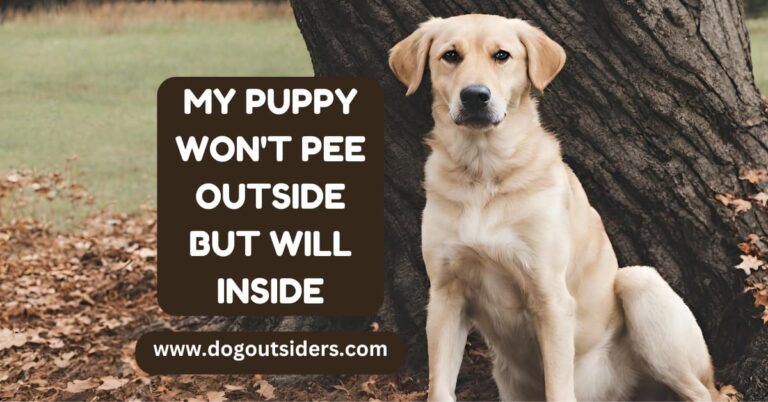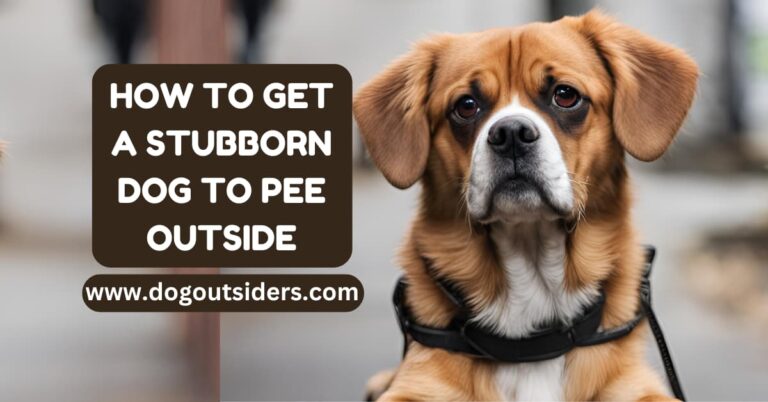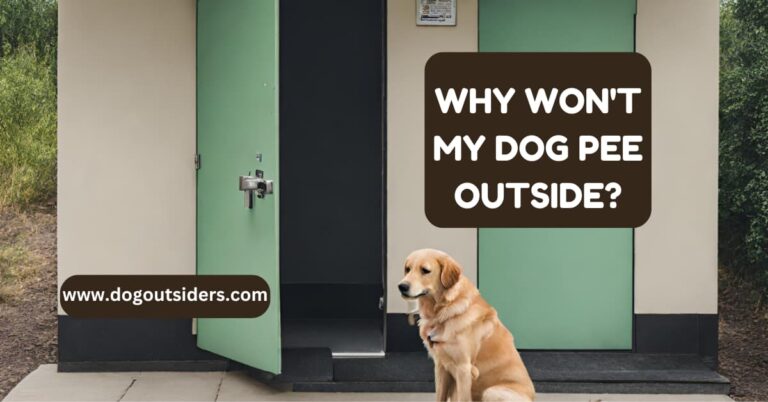Troubled because your “dog won’t go outside alone“? It can be frustrating when your furry friend won’t venture out without you. From building confidence to addressing underlying fears, learn how to support your canine companion in embracing solo outdoor excursions. Say goodbye to the struggle of coaxing your dog out the door and hello to stress-free walks and playtime in the fresh air.
Understanding Your Dog’s Reluctance
Signs of Fear or Discomfort
Observe your dog’s body language closely when trying to understand why they won’t go outside alone. Look for subtle cues like ears pinned back, tail tucked, or cowering.
Fear can manifest differently in each dog, so it’s crucial to pay attention to these indicators. If your dog shows signs of fear or discomfort, it’s essential to address the underlying issue with gentleness and care.
Past Experiences
Consider any past experiences your dog may have had that could contribute to their reluctance. Traumatic events, such as loud noises, aggressive encounters with other animals, or even a negative experience during obedience training, can all play a role.
By understanding your dog’s history and possible triggers, you can better tailor your approach to help them overcome their fear. Creating a safe and positive environment is key to building their confidence and trust.
Importance of Patience and Positive Reinforcement
Patience is crucial when dealing with a fearful or reluctant dog. Rushing them into situations that cause anxiety can worsen the problem. Instead, use positive reinforcement techniques like treats, praise, and gentle encouragement to help them feel more comfortable.
Consistency and kindness are key in helping your dog build confidence and overcome their fears. With time and support, most dogs can learn to feel more at ease in various situations.
Identifying Health Issues and Behavior
Health Issues
Consult a veterinarian if your dog won’t go outside alone to rule out any underlying health issues. Look for changes in appetite, energy levels, or bathroom habits as potential symptoms of health problems. Your vet can conduct tests to pinpoint any health problems affecting your dog’s behavior.
Behavioral Changes
Monitor your dog for signs of stress or anxiety that may be causing their reluctance to go outside alone. Behavioral changes like excessive barking, destructive chewing, or pacing could indicate underlying issues. Addressing these behavioral issues through training or environmental changes can help your dog feel more comfortable going outside alone.
Addressing Separation and Outdoor Anxiety
Desensitization Techniques
Implement gradual desensitization techniques to help your dog overcome separation anxiety and fear of going outside alone. Start by exposing your dog to outdoor environments for short periods, gradually increasing the duration over time. This method helps your dog adjust slowly and feel more comfortable outside.
Safe Outdoor Environment
Create a safe and comfortable outdoor environment for your furry friend. Ensure the area is secure, free from potential hazards, and equipped with familiar items like toys or blankets. By providing a familiar and safe space, you can help alleviate your dog’s anxiety about being outdoors alone.
Building Confidence
Practice short outdoor sessions with your dog to build confidence and reduce anxiety. Engage in positive activities such as playtime or training exercises to create positive associations with being outside. By gradually increasing the length of these sessions, you can help your dog feel more at ease when venturing outdoors solo.

Navigating Noise Sensitivity and Fear
Specific Triggers
Fear during outdoor activities in dogs can be triggered by loud noises, unfamiliar sounds, or sudden movements. These triggers often lead to anxiety and whining, causing your dog to resist going outside alone.
Counterconditioning Methods
To help your dog overcome noise sensitivity and fear, counterconditioning can be effective. This involves associating the scary noise with something positive, like treats or toys. By doing this, you can gradually change your dog’s response to these noises.
Distractions and Noise-Free Zones
Providing distractions such as interactive toys or creating a noise-free zone in your yard can help ease your dog’s anxiety during outdoor time. These distractions can shift their focus away from the triggering sounds, making them feel more comfortable and secure.
Reversing Negative Outdoor Experiences
Positive Reinforcement
Introduce treats and toys, gradually associating them with outdoor spaces to create positive experiences for your dog. Start by placing these rewards near the door and eventually move them outside.
Encourage your furry friend to step outside willingly by offering high-value treats or playing with their favorite toy in the yard. This positive reinforcement helps in reshaping their perception of outdoor areas.
Building Trust
Avoid pressuring your dog to go outside alone. Instead, focus on building trust through patience and positive interactions. Spend time near the door, engaging in activities your dog enjoys, to make the outdoor environment feel safe.
Engage with your dog in a calm and reassuring manner when near the door. By avoiding any signs of impatience or frustration, you can help alleviate their anxiety about going outdoors alone.
Encouraging Positive Outdoor Interactions
Interactive Play
Engage your dog in interactive play sessions outdoors to create a positive association with the environment. Use toys or treats to make outdoor time enjoyable and rewarding. Keep the activities short and fun to prevent boredom.
Socialization Opportunities
Invite friendly dogs for outdoor playdates to boost your dog’s confidence and social skills. Monitor their interactions closely to ensure a safe and positive experience. Gradually increase the duration of these play sessions over time.
Regular Outdoor Routine
Incorporate daily walks or outdoor activities into your dog’s routine to familiarize them with the surroundings. Choose different routes or locations to keep things interesting and engaging. Reward good behavior with treats or verbal praise to reinforce positive outdoor behavior.
Desensitizing Techniques for Outdoor Comfort
Gradual Exposure
Introduce potty breaks gradually to help your dog feel more comfortable outside. Start by taking short walks near the bed area.Provide positive reinforcement with treats when your dog shows signs of relaxation during these outdoor excursions. Slowly increase the duration of these outings over time.
Systematic Desensitization
Implement a systematic desensitization approach by exposing your dog to outdoor stimuli in a controlled environment. Begin with small steps and gradually build up to more challenging scenarios.
Create a calm and reassuring environment during these sessions to help reduce any fear or anxiety responses your dog may exhibit. Consistency is key in helping your furry friend overcome their reluctance to go outside alone.
Reward-Based Training
Utilize potty training as an opportunity to reward calm behavior. Each successful outdoor trip should be celebrated with praise and treats, reinforcing positive associations with going outside.
Conclusion:
Understanding your dog’s reluctance, identifying potential health issues, addressing separation and outdoor anxiety, navigating noise sensitivity and fear, reversing negative outdoor experiences, and encouraging positive interactions are crucial steps in helping your furry friend feel comfortable outdoors. Desensitization techniques can further aid in building their confidence gradually.
FAQ’s:
Dogs may feel anxious due to separation, noise sensitivity, past negative experiences, or underlying health issues. Identifying the specific cause can help address and resolve this reluctance effectively.
Observing your dog’s overall behavior, physical symptoms, and any recent changes can provide clues. Consulting with a veterinarian is crucial to rule out any underlying health conditions that may be contributing to the behavior.
Gradual desensitization techniques, positive reinforcement, creating a safe outdoor environment, and establishing a consistent routine can help alleviate separation anxiety in dogs and encourage them to feel more comfortable going outside alone.
Introducing gradual exposure to outdoor stimuli, using counter-conditioning methods, providing calming aids like background noise or music, and offering positive reinforcement for calm behavior can assist in desensitizing dogs to noises and fears outdoors.
Implementing systematic desensitization, engaging in fun outdoor activities with rewards, ensuring safety and comfort during outings, and being patient while gradually reintroducing positive experiences can help reshape a dog’s perception of outdoor environments.







10 Comments